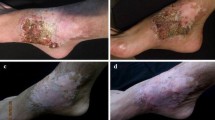Abstract
Photodynamic therapy (PDT) is a minimally invasive approach, in which a photosensitizer compound is activated by exposure to light. The activation of the sensitizer drug results in several chemical reactions, such as the production of reactive oxygen species and other reactive molecules, which presence in the biological site leads to the damage of target cells. Although PDT has been primarily developed to combat cancerous lesions, this therapy can be employed for the treatment of several conditions, including infectious diseases. A wide range of microorganisms, including Gram-positive and Gram-negative bacteria, viruses, protozoa, and fungi, have demonstrated susceptibility to antimicrobial PDT. This treatment might consist in an alternative for the management of fungal infections. Antifungal photodynamic therapy has been successfully employed against Candida species, dermatophytes, and Aspergillus niger. Chromoblastomycosis is an infection that involves skin and subcutaneous tissues caused by the traumatic inoculation of dematiaceous fungi species, being that the most prevalent are Fonsecaea pedrosoi and Claphialophora carrionii. In the present work, the clinical applications of PDT for the treatment of chromoblastomycosis are evaluated. We have employed methylene blue as photosensitizer and a LED (Light Emitting Diode) device as light source. The results of this treatment are positive, denoting the efficacy of PDT against chromoblastomycosis. Considering that great part of the published works are focused on in vitro trials, these clinical tests can be considered a relevant source of information about antifungal PDT, since its results have demonstrated to be promising. The perspectives of this kind of treatment are analyzed in agreement with the recent literature involving antifungal PDT.


Similar content being viewed by others
References
Moreira LM, Santos FV, Lyon JP, Maftoum-Costa M, Pacheco-Soares C, Silva NS. Photodynamic therapy: porphyrins and phthalocyanines as photosensitizers. Aus J Chem. 2008;61:741–54.
Calzavara-Pinton PG, Venturini M, Sala R. A comprehensive overview of photodynamic therapy in the treatment of superficial fungal infections of the skin. J Photochem Photobiol B: Biol. 2005;78:1–6.
Zeina B, Greenman J, Purcell WM, Das B. Killing of cutaneous microbial species by photodynamic therapy. Br J Dermatol. 2001;144:274–8.
Zeina B, Greenman J, Corry D, Purcell WM. Cytotoxic effects of antimicrobial photodynamic therapy on keratinocytes in vitro. Br J Dermatol. 2002;146:568–73.
Zeina B, Greenman J, Corry D, Purcell WM. Antimicrobial photodynamic therapy: assessment of genotoxic effects on keratinocytes in vitro. Br J Dermatol. 2003;148:229–32.
Marotti J, Aranha AC, Eduardo Cde P, Ribeiro MS. Photodynamic therapy can be effective as a treatment for herpes simplex labialis. Photomed Laser Surg. 2009;27:357–63.
Rossi R, Bruscino N, Ricceri F, Grazzini M, Dindelli M, Lotti T. Photodynamic treatment for viral infections of the skin. G Ital Dermatol Venereol. 2009;144:79–83.
Kacerovska D, Pizinger K, Kumpova M, Cetkovska P. Genital warts treated by photodynamic therapy. Skinmed. 2007;6:295–7.
Akilov OE, Kosaka S, O’Riordan K, Hasan T. Parasiticidal effect of delta-aminolevulinic acid-based photodynamic therapy for cutaneous leishmaniasis is indirect and mediated through the killing of the host cells. Exp Dermatol. 2007;16:651–60.
Asilian A, Davami M. Comparison between the efficacy of photodynamic therapy and topical paromomycin in the treatment of Old World cutaneous leishmaniasis: a placebo-controlled, randomized clinical trial. Clin Exp Dermatol. 2006;31:634–7.
Bristow C, Hudson R, Paget TA, Boyle RW. Potential of cationic porphyrins for photodynamic treatment of cutaneous leishmaniasis. Photodiag Photodyn Ther. 2006;3:162–7.
Akilov OE, Kosaka S, O’Riordan K, Hasan T. Photodynamic therapy for cutaneous leishmaniasis: the effectiveness of topical phenothiaziniums in parasite eradication and Th1 immune response stimulation. Photochem Photobiol Sci. 2007;6:1067–75.
Silva NS, de Ribeiro CM, Machado AH, Pacheco-Soares C. Ultrastructural changes in T. foetus after treatments with AlPcS4 and photodynamic therapy. Vet Parasitol. 2007;146:175–81.
Bliss JM, Bigelow CE, Foster TH, Haidaris CG. Susceptibility of Candida species to photodynamic effects of photofrin. Antimicrob Agents Chemother. 2004;48:2000–6.
Munin E, Giroldo LM, Alves LP, Costa MS. Study of germ tube formation by C. albicans after photodynamic antimicrobial chemotherapy (PACT). J Photochem Photobiol B: Biol. 2007;88:16–20.
Giroldo LM, Felipe MP, Oliveira MA, Munin E, Alves LP, Costa MS. Photodynamic antimicrobial chemotherapy (PACT) with methylene blue increases membrane permeability in C. albicans. Lasers Med Sci. 2009;24:109–12.
Dovigo LN, Pavarina AC, Oliveira M, Garcia E, Giampaolo ET, Vergani CE, Bagnato VS. Fungicidal effect of photodynamic therapy against fluconazole-resistant C. albicans and C. glabrata. Mycoses. 2009;54:123–30.
Calzavara-Pinton PG, Venturini M, Capezzera R, Sala R, Zane C. Photodynamic therapy of interdigital mycoses of the feet with topical application of 5-aminolevulinic acid. Photodermatol Photoimmunol Photomed. 2004;20:144–7.
Smijs TGM, Schuitmaker HJ. Photodynamic Inactivation of the dermatomycete T. rubrum. Photochem Photobiol. 2003;77:556–60.
Friedberg JS, Skema C, Baum ED, Burdick J, Vinogradov SA, Wilson DF, Horan AD, Nachamkin I. In vitro effects of photodynamic therapy on A. fumigatus. J Antimicrob Chemother. 2001;48:105–7.
Donnelly RF, McCarron PA, Tunney MM. Antifungal photodynamic therapy. Microbiol Res. 2008;163:1–12.
Qiao J, Li R, Ding Y, Fang H. Photodynamic therapy in the treatment of superficial mycoses: an evidence-based evaluation. Mycopathologia. 2010;170:339–43.
Queiroz-Telles F, Esterre P, Perez-Blanco M, Vitale RG, Salgado CG, Bonifaz A. Chromoblastomycosis: an overview of clinical manifestations, diagnosis and treatment. Med Mycol. 2009;47:3–15.
Author information
Authors and Affiliations
Corresponding author
Rights and permissions
About this article
Cite this article
Lyon, J.P., de Maria Pedroso e Silva Azevedo, C., Moreira, L.M. et al. Photodynamic Antifungal Therapy Against Chromoblastomycosis. Mycopathologia 172, 293–297 (2011). https://doi.org/10.1007/s11046-011-9434-6
Received:
Accepted:
Published:
Issue Date:
DOI: https://doi.org/10.1007/s11046-011-9434-6




